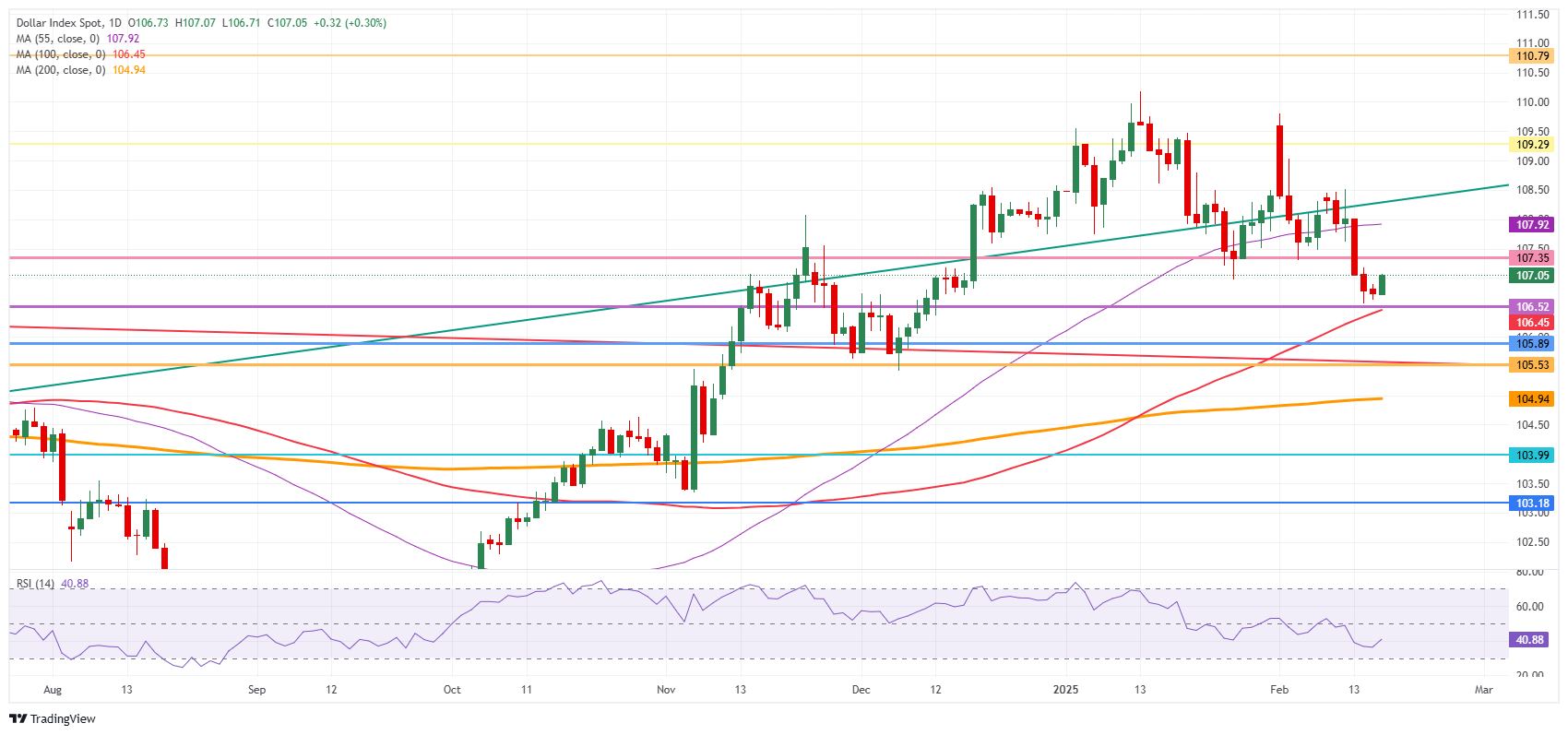- The US Dollar sees gains across the board after NY State Manufacturing grew again.
- Traders are seeing early comments out of Riyadh not bearing much positive signs.
- The US Dollar Index (DXY) pops above 107.00 on the back of US-Russian headlines.
The US Dollar Index (DXY), which tracks the performance of the US Dollar (USD) against six major currencies, is trading above 107.00 and is looking at 0.50% gains at the time of writing on Tuesday after disappointing comments on day one of United States (US) and Russia talks on Ukraine. Several US officials have held a meeting with their Russian counterparts this Tuesday in Riyadh, Saudi Arabia, to try and work out a ceasefire or peace deal for Ukraine. First headlines that came out as the meeting ended, are that Russia is not seeing the need for a meeting between US President Donald Trump and Russian President Vladimir Putin this month, due to the number of demands Russia still has.
The economic calendar is again rather calm on Tuesday. The main event, the New York Empire State Manufacturing Index data for February already came out in surprise and snapped its contraction by turning positive for the first time in a couple of months. Up ahead, Federal Reserve Bank of San Francisco President Mary Daly and Federal Reserve Vice Chair for Supervision Michael Barr are set to speak later this Tuesday.
Daily digest market movers: Not what Trump wants
- Markets are heading into Gold, US bonds and the Greenback after comments that the US-Russia talks did not go as smooth as hoped for. Russia sticks to its demands and is not looking for a quick solution, rather the long way of negotiations, while it feels that war fatigue at the Ukraine side is creating a positive Russian momentum on the ground. With funding and military equipment quickly being used up, both Europe and US are not really in favor to still write blank cheques for Ukraine to still fight off Russian troops.
- The New York Empire State Manufacturing Index for February came out of contraction by 5.70, beating the -1 expectation and compared to the previous -12.60.
- At 15:00 GMT, the National Association of Home Builders (NAHB) will release its Housing Market Index for February, which is expected to rise steadily by 47, from 47 in January.
- Federal Reserve Bank of San Francisco President Mary Daly and Federal Reserve Vice Chair for Supervision Michael Barr will speak later this Tuesday at 15:20 GMT and 18:00 GMT, respectively.
- Equities are flat to marginally in the green ahead of the US trading session.
- The CME FedWatch tool shows a 49.8% chance that interest rates will remain unchanged at current levels in June.
- The US 10-year yield is trading around 4.52% and is ticking higher in some risk off sentiment.
US Dollar Index Technical Analysis: There is some retrieve
The US Dollar Index (DXY) is facing too many loose ends to choose a surefooted direction. Plenty of catalysts and headlines are still expected, ranging from headlines on Ukraine and Europe to more details on US President Trump’s reciprocal tariffs, all ahead of this weekend’s German election. The US Dollar could start to outperform if a peace deal is brokered without Europe, missing the opportunity to play an important role in the new world order.
On the upside, the previous support at 107.35 has now turned into a firm resistance. Further up, the 55-day SMA at 107.92 must be regained before reclaiming 108.00.
On the downside, look for 106.52 (April 16, 2024, high), 106.45 (100-day SMA), or even 105.89 (resistance in June 2024) as support levels. As the Relative Strength Index (RSI) momentum indicator in the daily chart shows room for more downside, the 200-day SMA at 104.94 could be a possible outcome.
US Dollar Index: Daily Chart
Fed FAQs
Monetary policy in the US is shaped by the Federal Reserve (Fed). The Fed has two mandates: to achieve price stability and foster full employment. Its primary tool to achieve these goals is by adjusting interest rates. When prices are rising too quickly and inflation is above the Fed’s 2% target, it raises interest rates, increasing borrowing costs throughout the economy. This results in a stronger US Dollar (USD) as it makes the US a more attractive place for international investors to park their money. When inflation falls below 2% or the Unemployment Rate is too high, the Fed may lower interest rates to encourage borrowing, which weighs on the Greenback.
The Federal Reserve (Fed) holds eight policy meetings a year, where the Federal Open Market Committee (FOMC) assesses economic conditions and makes monetary policy decisions. The FOMC is attended by twelve Fed officials – the seven members of the Board of Governors, the president of the Federal Reserve Bank of New York, and four of the remaining eleven regional Reserve Bank presidents, who serve one-year terms on a rotating basis.
In extreme situations, the Federal Reserve may resort to a policy named Quantitative Easing (QE). QE is the process by which the Fed substantially increases the flow of credit in a stuck financial system. It is a non-standard policy measure used during crises or when inflation is extremely low. It was the Fed’s weapon of choice during the Great Financial Crisis in 2008. It involves the Fed printing more Dollars and using them to buy high grade bonds from financial institutions. QE usually weakens the US Dollar.
Quantitative tightening (QT) is the reverse process of QE, whereby the Federal Reserve stops buying bonds from financial institutions and does not reinvest the principal from the bonds it holds maturing, to purchase new bonds. It is usually positive for the value of the US Dollar.
(This story was corrected on February 18 at 13:51 GMT to say that the US bond market is not closed but trading and heading higher due to some risk off.)








